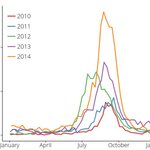Immunology

We humans have an innate tendency to recognize patterns. This ability has helped us survive by learning important skills such as how to distinguish danger (predators and poisonous plants, for instance) from important resources (food sources and safe shelter) and knowing the right time of year to plant crops.
But the same ability can sometimes convince us we’re seeing a meaningful pattern when it isn’t there. Gamblers detect “patterns” in lottery numbers and roulette wheels, fortune tellers detect “meaning” in chance events and weave a story. As a society we carry all kinds of similar…

Rabbits have long been considered immune to prion disease, but recently scientists have shown that they can--under certain circumstances--get transmissible spongiform encephalopathy (or TSE, the scientific term for the fatal brain disease caused by prions). Two studies address what makes rabbits hard to infect with prions and how their resistance can be overcome.
Prions are misfolded versions of a protein that, in its normal form (called PrPC, encoded by the PRNP gene), is found mainly in nerve cells of all mammals. The misfolded prions can trigger a domino effect by causing folding changes…

A research group has made a breakthrough discovery which could help thousands of young girls worldwide who are suffering from a rare yet debilitating form of epilepsy. The United States pharmaceutical company Marinus Pharmaceuticals is now recruiting affected girls as part of the world's first clinical trial to test the therapy.
Professor Jozef Gecz, from the University of Adelaide's Robinson Research Institute, was a key player in identifying the responsible gene and mutations in this female-only epileptic syndrome, in 2008 and has now found a treatment for this disorder.
"We…

Flu vaccines can be a shot in the dark - they must they be given yearly and there's no guarantee the strains against which they protect will be the ones circulating once the season arrives.
New research suggests it may be possible to harness a previously unknown mechanism within the immune system to create more effective and efficient vaccines against this ever-mutating virus.
In a Cell paper, a team describes a new strategy that revolves around antibodies, immune proteins that target specific foreign proteins, called antigens. One end of the antibody latches on to an antigen, the other…

Every time you put on bug spray this summer, you're another front in the ongoing war between humans and mosquitoes - and being a citizen scientist in a complex evolutionary experiment.
Scientists have found that between 5 and 20 percent of a mosquito population's genome is subject to evolutionary pressures at any given time, creating a strong signature of local adaptation to environment and humans. This means that individual populations are likely to have evolved resistance to whatever local selection pressures are typical in their area, and that understanding the genomes of those populations…

The 2014-2015 flu vaccine didn't work as well compared to previous years because the H3N2 virus recently acquired a mutation that concealed the infection from the immune system. A study published on June 25 in Cell Reports reveals the major viral mutation responsible for the mismatch between the vaccine strain and circulating strains. The research will help guide the selection of viral strains for future seasonal flu vaccines.
"Flu vaccines work best when they are similar to most circulating flu strains," says senior study author Scott Hensley of the Wistar Institute. "The World Health…

Although we know influenza viruses circulate in temperate, populated parts of Australia every winter, predicting the precise timing and relative intensity of flu seasons is a fraught undertaking.
Still, this doesn’t deter people from making predictions. And when predictions mainly rely on data from notification of influenza cases to health authorities, each year seems more dire than the last. Indeed, using only notifications to predict influenza seasons is increasingly likely to exaggerate its seriousness. But the practice remains common and claims such as “Australia could be in for its…

Children are more likely to have a repeat, delayed anaphylactic reaction from the same allergic cause, depending on the severity of the initial reaction.
Anaphylaxis is a severe, allergic reaction that is rapid in onset and can result in death. Some children are at risk of delayed ('biphasic') anaphylactic reactions. Delayed reactions occur when the initial symptoms of allergic reaction go away but then return hours or days later without exposure to the initial substance that caused the reaction.
A study led at the Children's Hospital of Eastern Ontario (CHEO) Research Institute looked…

The supplements industry has embraced claims suggesting a link between soy intake and decreased asthma severity, but a randomized, double-blind study, where half of the participants took a soy isoflavone supplement twice daily for six months, and the other half took a placebo, found that soy supplements do not improve lung function for patients with asthma.
Supplements are an unregulated, multi-billion industry, and it got that way using bold claims about treating and preventing disease, but they do it without real data. Instead they rely on…

Measles needs only a two-dose vaccine during childhood for lifelong immunity while the influenza virus mutates constantly and requires a yearly shot to get even a certain percentage of protection.
What explains that? Surface proteins that the measles virus uses to enter cells are ineffective if they suffer any mutation, meaning that any changes to the virus come at a major cost, according to a new paper.
The researchers used a high-throughput approach to mutate all of the genes in a virus in one experiment -- a useful way to understand the future of viral evolution. They inserted…